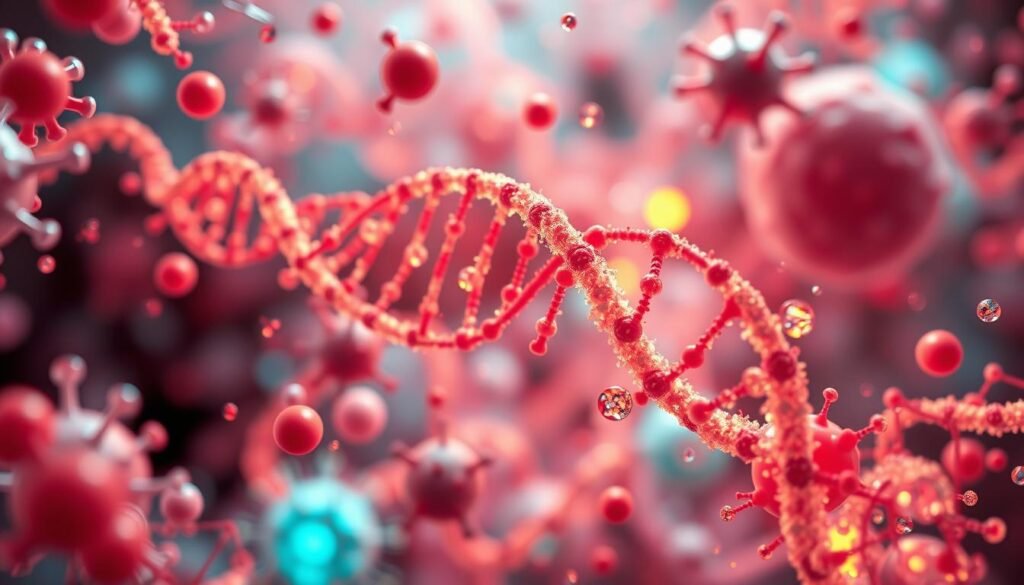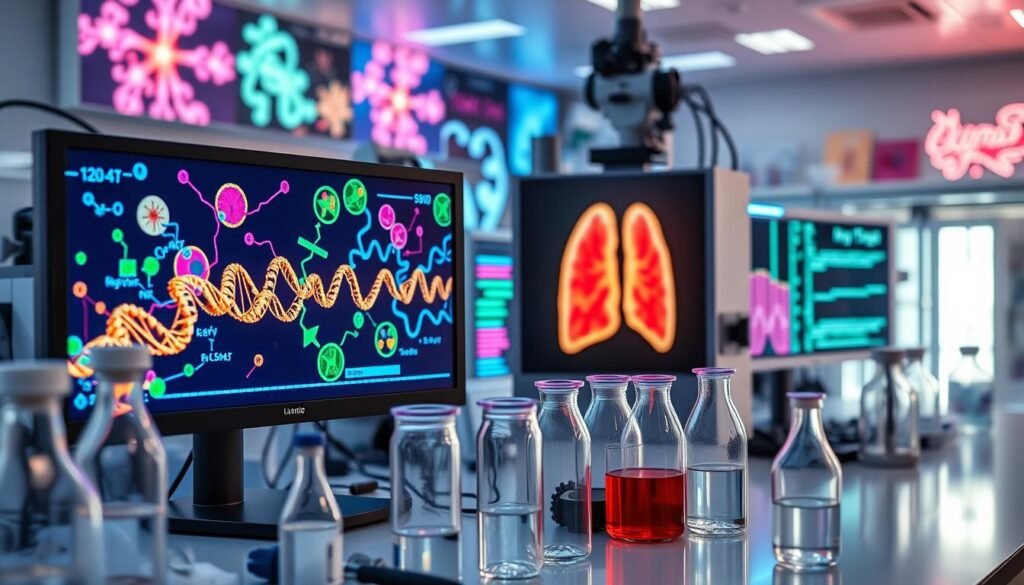About 60% of advanced non-small cell lung cancer patients have tumors with genetic changes. These can be aimed at for better treatment. Biomarkers are key in finding lung cancer early and making treatments that really fit the patient. As science gets better at spotting these markers, like EGFR mutations and ALK shifts, it’s crucial. This way, doctors can pick treatments that work best for each patient, making their chances better.
Even with big advancements, 61% say there are still hurdles to getting biomarker tests. This shows we need more research and information about finding biomarkers in cancer treatment. Using these markers in regular care changes how we fight lung cancer. It helps make new drugs and shifts how we treat it.
Key Takeaways
- Approximately 60% of advanced NSCLC patients have targetable genetic mutations.
- Biomarker testing aids in identifying patients for personalized treatment paths.
- Challenges remain, with 61% of patients facing barriers to biomarker testing.
- Advancements in molecular diagnostics are crucial for early cancer detection.
- Integrating biomarkers into clinical practice improves treatment modalities.
Introduction to Lung Cancer and Its Challenges
Lung cancer is a top cause of cancer deaths worldwide. It’s worrying, with more than 2.1 million new cases found in 2018. These led to about 1.8 million deaths. In the United States, around 221,200 new cases are reported each year. This contributes to the high mortality rates linked to this illness. The lack of early detection and the complex nature of lung cancer add to the problem.
The outlook for patients found at later stages is worrisome. For early stages I and II, the five-year survival rate is 56%. Yet, only 16% are diagnosed early. Hence, the overall five-year survival rate is under 20%. This gap points out major lung cancer challenges in quick diagnosis and treatment.
About 80% to 85% of lung cancers are non-small cell lung carcinoma (NSCLC). This is the most common type. Adenocarcinoma makes up 40% of these, while squamous cell carcinoma is about 25% to 30%. Small cell lung carcinoma (SCLC) is around 10% to 15% and is very aggressive. It has a low survival rate. The variety among lung cancers makes finding the right treatment for each patient hard.
The fight against lung cancer is ongoing. But, advances in molecular testing and targeted therapy bring hope. Knowing about biomarkers like EGFR mutations and ALK translocations helps a lot in treatment. It especially aids those with NSCLC subtypes. For more details, look at this review article.
Importance of Early Detection in Lung Cancer
Early detection in lung cancer is crucial. It greatly affects treatment success and the patient’s overall outlook. Using low-dose CT scans works well for early spotting, especially in those who have smoked a lot. Around 1.8 million people die from lung cancer each year. This fact shows why we need better ways to find it early.
Only 20% of people with lung cancer live more than five years after they’re diagnosed. Most cases, about 75%, are found when the cancer is advanced, in stages III or IV. This is when treating the cancer is hardest. But if found at stage IA, the five-year survival rate jumps to 92%. This shows how vital early detection truly is.
There’s hope with new diagnostic improvements. Scientists are looking at serum biomarkers as a way to catch lung cancer sooner. Doctors working together to use these new methods is key. Making these diagnostic tools better is essential for improving how we treat patients.
Current Advances in Lung Cancer Biomarkers
Recent advances in lung cancer biomarkers have really changed how we screen and manage lung cancer. These innovations help with better accuracy and make things easier for patients through new methods and tech.
Molecular Diagnostics: Shaping the Future of Lung Cancer Screening
Molecular diagnostics are key in finding lung cancer early. They provide info on specific genetic changes to guide treatment. Techniques like next-generation sequencing (NGS) give a full look at genetic shifts. This is essential in understanding molecular diagnostics. One example is the use of osimertinib (Tagrisso), a leading EGFR inhibitor. It uses these advances to better treat patients with late-stage lung cancer.
Liquid Biopsy Techniques for Non-Invasive Testing
Liquid biopsy methods are changing non-invasive testing by letting doctors test tumor DNA from blood samples. These methods make it easier to track how well treatment is working and the cancer’s progress. They also cause less discomfort for patients. For example, studies show that ctDNA can find about half of early-stage lung tumors. This shows how useful liquid biopsy could be in routine lung cancer checks.

| Technique | Usefulness | Sensitivity | Specificity |
|---|---|---|---|
| Molecular Diagnostics (NGS) | Identifying genetic mutations | Varies based on mutation | High |
| Liquid Biopsy (ctDNA) | Monitoring treatment response | ~50% | Moderate |
| Methylation Profiling (cfDNA) | Early-stage detection | 67.3% | ~99.3% |
| Cancer Personalized Profiling by deep Sequencing (CAPP-Seq) | Detecting early-stage lung cancer | ~50% | High |
This table shows how various techniques help detect lung cancer. It highlights the importance of molecular diagnostics and liquid biopsy in today’s lung cancer screening.
Lung Cancer Biomarkers: Key Types and Their Functions
Lung cancer biomarkers are vital in fighting this top cause of cancer deaths. Circulating tumor DNA and exosomes are at the forefront for early detection and tracking treatment. They play a big role in improving how we diagnose and manage lung cancer.
Circulating Tumor DNA (ctDNA) in Early Detection
Circulating tumor DNA is key for finding lung cancer early. It’s a piece of DNA from tumors found in the blood. It tells us about changes in the tumor. Knowing this early on helps doctors decide on the best treatment. ctDNA shows great promise in improving patient care.
Exosomes as Potential Biomarkers for Monitoring Treatment Response
Exosomes are tiny bubbles from cells that are promising for checking how well lung cancer treatment is working. They contain info that tells us how the tumor is behaving. Knowing about exosomes helps doctors understand how well treatment is working. This method is changing how we manage lung cancer.

| Type of Biomarker | Function | Significance |
|---|---|---|
| Circulating Tumor DNA (ctDNA) | Early detection and genetic profiling | Facilitates timely diagnosis and therapy decisions |
| Exosomes | Monitoring treatment response | Indicates tumor dynamics and resistance mechanisms |
| PD-L1 Expression | Assessing immunotherapy suitability | Identifies candidates for immunotherapy |
| SOX2 Overexpression | Characterizing squamous cell carcinoma | Indicates aggressive tumor types |
Proteomics and Transcriptomics in Lung Cancer Research
Proteomics and transcriptomics are key parts of lung cancer research. They help us understand how tumors work and find better ways to detect and treat them.
Proteomics looks at all the proteins in a sample. It shows how proteins change and could make cancer worse. One study checked 23 protein areas in lung cancer and found important details about how tumors act.
Transcriptomics looks at RNA to see what genes are doing. It found 84 gene areas linked to lung cancer. These details help doctors understand the disease and might guess how it will go.

The use of both proteomics and transcriptomics shows how related they are, with a Pearson’s correlation of 0.43. This shows using different methods helps us get a full picture of lung cancer.
Together, these fields make our knowledge of lung cancer deeper. They help find new markers for the disease. This is key for creating treatment plans early, especially since most cases are found late.
For more about lung cancer treatments, visit this article.
| Type of Analysis | Regions of Interest (ROIs) | Average Survival (Years) |
|---|---|---|
| Proteomics | 23 pROIs | 6.5 |
| Transcriptomics | 84 tROIs | N/A |
Comprehensive Genomic Profiling and Its Role in Personalized Therapy
Comprehensive genomic profiling plays a key role in advancing personalized therapy for lung cancer. It identifies specific mutations within tumors. This lets doctors create treatments that match each patient’s unique genetics. In a study, 64 out of 69 lung cancer samples were successfully analyzed. They found, on average, four genomic changes per sample, ranging from 0 to 23 changes.
The genes changed most often were TP53, KRAS, and CDKN2A/B. This shows how varied mutations can be in affecting treatment. Thanks to targeted therapies, 20% of studied patients began personalized treatments. Interestingly, these personalized treatments worked well in 61.5% of cases in the precision oncology group.
Patients treated with personalized therapy based on their genomic profiles saw major benefits. They had a longer period without their cancer getting worse. Specifically, they had a median progression-free survival (PFS) of 151 days. This is compared to 83 days for patients treated with standard chemotherapy (p=0.0165). It shows that therapies tailored using comprehensive genomic profiling can lead to better results. This underscores its importance in contemporary lung cancer care.
In the study, identifying NCCN markers was crucial. Tissue-based genomic profiling found key mutations in 66% of cases. However, liquid-based profiling spotted mutations in 43% of cases. Despite these differences, tissue profiling was essential. It caught 23% more biomarkers than liquid profiling. This emphasizes the need for combining both methods. It gives a fuller understanding of a patient’s cancer.
| Parameter | Results |
|---|---|
| Number of patients profiled | 64 out of 69 |
| Median alterations detected | 4 (range 0-23) |
| Most altered genes | TP53, KRAS, CDKN2A/B |
| Patients receiving personalized therapy | 13 out of 64 (20%) |
| Effectiveness of personalized treatment | 8 out of 13 (61.5%) |
| Median PFS for personalized treatment | 151 days |
| Median PFS for chemotherapy | 83 days |
Recent Developments in Machine Learning for Biomarker Detection
Machine learning is changing how we find biomarkers in lung cancer. It’s especially useful for lung cancer screening. The latest methods can sift through huge datasets to find key biomarkers. This is important because lung cancer often goes unnoticed until it’s advanced. Sadly, only about 18% of people diagnosed survive.
Tools like K-nearest neighbor and Support Vector Machine are game-changers. They help find important details for spotting tumors early. For example, using six specific biomarkers has resulted in almost perfect test scores. This shows how machine learning can make diagnoses more accurate.
Over 200 studies have used AI to find lung cancer biomarkers. These markers can be of different types such as molecular or radiologic. Understanding these helps doctors take better care of their patients. Each type of biomarker has its own role, like helping predict how a patient will respond to treatment.
Lung cancer is behind a lot of cancer deaths, so better detection is vital. New machine learning models are being made to find these biomarkers more efficiently. This could help doctors plan better treatments. The outlook for lung cancer detection is getting brighter thanks to machine learning.
| Study Focus | Machine Learning Techniques | Target |
|---|---|---|
| Early Tumor Prediction | KNN, SVM, Neural Network | NSCLC |
| Metabolic Biomarker Identification | AdaBoost, Random Forest | Early Detection |
| Risk Assessment | Naïve Bayes | Survival Rates |
Conclusion
Studying lung cancer biomarkers is key for better early detection and new treatment strategies. Research like the NLST and NELSON trials shows that new screening methods can greatly reduce lung cancer deaths. Biomarkers could make these screenings even more effective, helping to personalize care.
As we understand more about lung cancer, the role of molecular diagnostics and liquid biopsies becomes clearer. These tools help with correct risk assessments and improve decision-making in treatment. They aim to lower false negatives, leading to improved patient care.
The future of fighting lung cancer involves teamwork between researchers, healthcare providers, and organizations. This cooperation will help bring new lung cancer biomarkers into regular use, giving patients hope for better detection and treatment. As innovation continues, the importance of ongoing research grows.